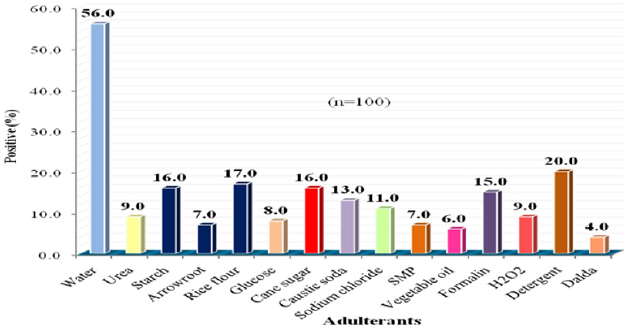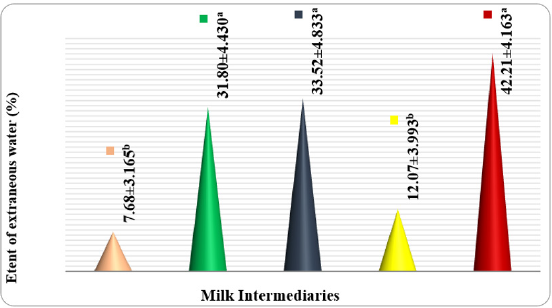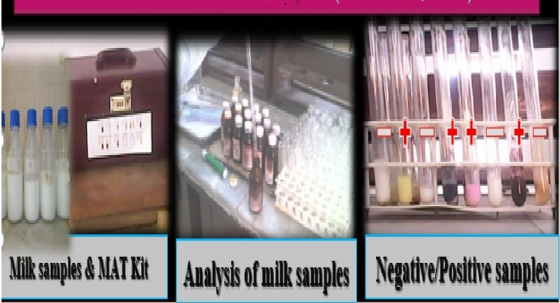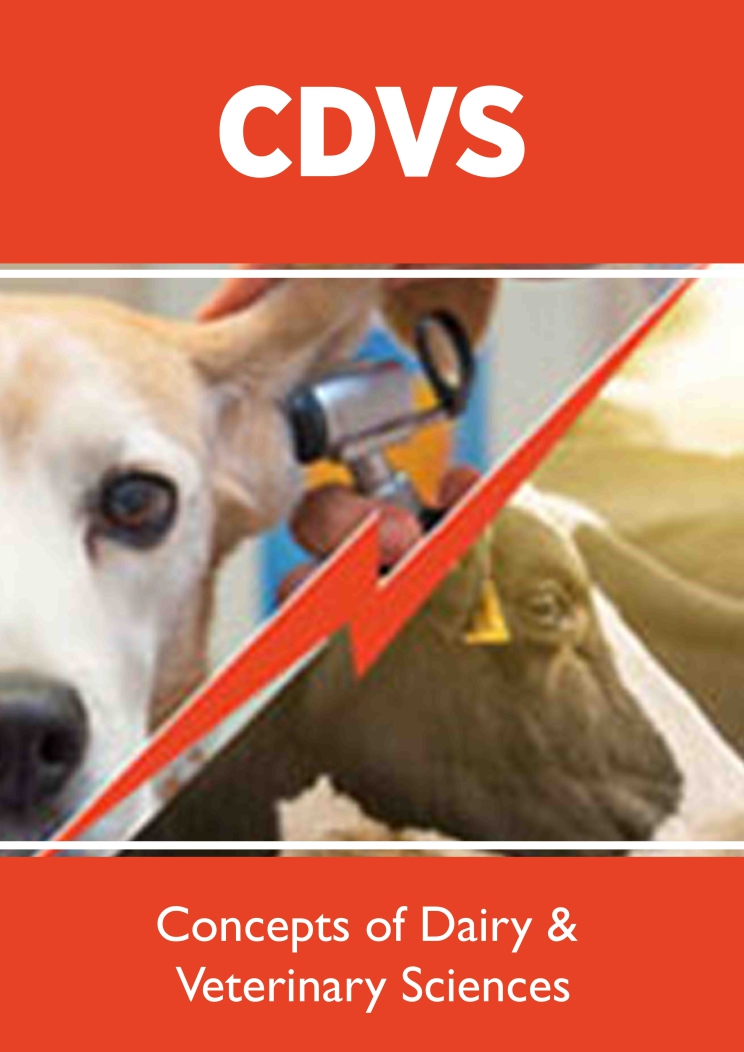
Lupine Publishers Group
Lupine Publishers
Menu
ISSN: 2637-4749
Research Article(ISSN: 2637-4749) 
Evaluation of Milk Quality Vended at Nosharoferoz City of Sindh, Pakistan Volume 2 - Issue 4
Ghulam Shabir Barham1*, Muhammad Haroon Baloch2, Atta Hussain Shah1, Gul Bahar Khaskheli1, Shoaib Ahmed Pirzado3, Mansoor Tariq4 and Asad Ali Khaskheli3
- 1Department of Animal Products Technology, Sindh Agriculture University, Tandojam, Pakistan
- 2Department of Livestock Management, Sindh Agriculture University, Tandojam, Pakistan
- 3Department of Animal Nutrition, Sindh Agriculture University, Tandojam, Pakistan
- 4Department of Veterinary Pathology, Sindh Agriculture University, Tandojam, Pakistan
Received: March 22, 2019; Published: April 17, 2019
Corresponding author: Dr. Ghulam Shabir Barham, Department of Animal Products Technology, Faculty of Animal Husbandry & Veterinary Sciences, Sindh Agriculture University, Tandojam, Pakistan
DOI: 10.32474/CDVS.2019.02.000144
Abstract
Current study was designed to assess the quality of milk vended by different intermediaries at the surrounding of Nosharoferoz city during the year 2016-17. A total of 100 milk samples were collected each of twenty (n=20) from dairy farms, milk collectors, milk venders, processors and retailers brought in the Department of Animal Products Technology, Faculty of Animal Husbandry and Veterinary Sciences, Sindh Agriculture University Tandojam for analysis. Among all the detected adulterants in market milk, water was at the top followed by detergent, rice flour, starch, cane sugar, formalin, caustic soda, salt, urea, H2O2, glucose, arrowroot, SMP, vegetable oil and dalda ghee. The extent of extraneous water in milk sold by retailers, milk venders and milk collectors were found significantly (P˂0.05) high compared to processors and dairy farms. Noteworthy increase was observed in pH value and the freezing point stirred towards water in milk vended by retailer, milk venders and milk collectors, while the specific gravity of milk obtained by dairy farms and processors was noticed comparatively (P<0.05) high. The fat, protein, lactose and ash contents of milk samples were found comparatively (P<0.05) low at retailer, milk vender and milk collector level than processor and dairy farm.
Keywords: Market milk; Extraneous water; Physico-chemical quality; Nosharoferoz; Sindh; Pakistan
Introduction
Milk is the best and cheapest source of nutrition and an article of daily diet, easily accepted and used by all the age groups in rural as well as in urban areas. Milk, if present in its natural form, has high food value and supplies good quality nutrients like energy providing lactose and fat, body building proteins, the bone forming calcium, health promoting vitamins and minerals in significant amount than any other single food [1]. Historical evidence indicates that the nations which used to obtain highest calories from milk and milk products were more civilized and capable of having sound administration and such societies enjoy almost complete freedom from nutritional disease. In contrast, the poorly or underdeveloped areas of the world have a primitive or non-existent milk supply and have numerous inhabitants suffering from nutritional deficiency, especially infants and children [2]. No doubt, milk is a perishable commodity and is likely to be spoiled during summer season when weather becomes very hot [3]. Unfortunately, due to unorganized and non-regulated marketing systems, the quality of milk is hardly maintained at consumer level [4]. In order to keep milk temporarily fresh, some unethical activities are usually adapted to prevent the financial losses due to the spoilage of milk during its transportation and sale [5]. It has been observed that adulteration of milk is one of the most serious issues that the dairy sector of Pakistan is today facing, causing not only major economic losses for the processing industry, but also a major health risk for the consumers. Due to the spread of small holding farmers and consequent supply chain complexities, milk handling processes in the traditional system are extremely unhygienic and there is no enforcement of standards, so the result is poor quality products. In order to keep milk temporarily fresh, middlemen commonly add ice to the milk, which results in dilution of milk solids. Compounding the problem, middlemen attempt to counter the dilution by adding vegetable oil, starch, flour, sugarcane, whey powder, skim milk powder, and other ingredients to extend the solid content of the milk [6]. Besides, some adulterants like detergent are used to enhance the cosmetic nature of milk. When water is added in milk, its foamy appearance diminishes, so to give milk a foamy appearance artificially detergents are added in it. Hair removing powders (calcium thioglycolate/ potassium thioglycolate/calcium salts of thioglycolic acid) and urea are added for whitening of milk and giving it genuine look. Only few grams of urea are enough to bring milk in its original state [7]. The adulteration of milk may cause significant problems for human health for example; the milk adulterated with contaminated water is a serious health hazard because of potential waterborne diseases. Other adulterants like detergents, urea, starch, caustic soda, formalin, hydrogen peroxide and other synthetic components may cause impairments, food poisoning, gastroenteritis, vomiting, nausea, renal failure, liver damage, heart problems, cancer or even death in all age groups [8,9]. Feeling gravity of problem, study has been designed, to evaluate the hygienic and physicochemical quality of milk vended by various milk intermediaries at Nosharoferoz city of Sindh, Pakistan.
Materials and Methods
Collection of Milk Samples
A total of 100 unprocessed market milk samples were collected from different milk intermediaries; dairy farms, milk collectors, milk venders, processors and retailers from the locality of Nosharoferoz city of Sindh province of Pakistan for the evaluation of hygienic and physico-chemical quality of milk.
Assessment of Hygienic Quality
For the evaluation of hygienic quality all the collected milk samples were screened for the various adulterants as per standard procedure as reported by Tipu [3] and Khaskheli [10] and the standard procedure for screening of adulterants was mentioned in Figure 1.
Presence of Extraneous Water
The presence of extraneous water in market milk was detected from depression of freezing point through Cryoscope as reported by Association of Official Analytical Chemists [11]. The value of freezing point of market milk greater than the values of freezing point of control was assumed as presence of extraneous water in market.
Extent of Extraneous Water in Market Milk
Extent of extraneous water in market milk was observed from the depression of freezing point (through Cryoscope) and calculated by subtracting the observed freezing point of market milk from that of freezing point of base (control) and thereafter by dividing it with freezing point of base using following formula [11].

Physico-Chemical Analysis
pH value
The pH value of market milk samples was recorded by using pH meter according to the method of AOAC [11]. The milk sample was taken in to a beaker, electrodes along with temperature probe was inserted to sample. The constant reading appeared on pH meter base was noted and recorded as pH value of milk sample.
Titratable acidity
The Titratable acidity of spiked milk samples was determined according to the method of AOAC [11]. Milk sample (9ml) with phenolphthalein (3drops) was titrated using N/10 (0.01N) NaOH solution till appearance of light pink colour. The volume of N/10 NaOH solution used in the titration was noted. Thereafter following formula was applied to calculate the acidity percent in milk samples.

Freezing Point
Freezing point of market milk samples was determined according to the method of AOAC [11] by using Cryoscopy technique. Milk sample was loaded on the Cryoscope. The constant reading appeared on the screen of Cryoscope was noted and recorded as freezing point of milk.
Specific Gravity
Specific gravity of market milk samples was determined according to the method of Association of Official Analytical Chemists [11] using pycnometer. The density of milk was measured against the density of standard (water). The pre-weighed pycnometer was filled with standard reference fluid (water) to some pre-determined level at 20oC and weight was taken. Similarly, pre- prepared milk sample was filled in pycnometer at similar level and temperature and weighed. Specific gravity of milk was calculated by the following formula:

Fat Content
Fat content of market milk samples was determined by Gerber method as described by James [12]. Milk sample (11ml) was mixed with 90% sulfuric acid (10ml) and amyl alcohol (1ml) in butyrometer and closed with rubber cork. The butyrometer was placed in a Gerber centrifuge machine and centrifuged for 5 min. at 1100 round per minute (r.p.m). The butyrometer was transferred to water bath at 65°C to make fat prominent on butyrometer scale. The fat percentage was noted on the butyrometer scale.
Protein Content
Protein content of market milk samples was determined according to the method of British Standards Institution [13]. The milk sample (5g) was digested using Micro-Kjeldhal digester in the presence of catalyst (0.2g copper sulfate and 2.0g sodium sulfate) where sulfuric acid (30ml) was used as an oxidizing agent. The digested sample was diluted with distilled water (250ml). Then 5ml portion from the diluted sample was distilled with 40% NaOH using Micro-Kjeldhal distillation unit where steam was distilled over 2% boric acid (5ml) containing an indicator (Bromocresol green) for 3 minutes. The ammonia trapped in boric acid was determined by titrating with 0.1N HCl. The nitrogen percentage was calculated using the following formula:

Lactose content
Lactose content of market milk samples was determined by subtracting the sum of total percent of fat, protein ash content from that of TS content of milk as reported by James [12]. Lactose content of market milk samples were calculated by using following formula:

Ash Content
Ash content of market milk samples was determined by Gravimetric method as described by AOAC [11] using muffle furnace. The milk sample (5g) was taken in pre-weighed crucible and transferred to muffle furnace (550°C) for 4±1 h. Ignited sample was transferred to desiccator having silica gel as desiccant. After 1h the dish was weighed, and the content was calculated by following formula:

Statistical Analysis
The data were analyzed through computerized statistical package i.e. Student Edition of Statistix (SXW), Version 8.1 (Copyright 2005, Analytical Software, USA). The data so obtained was tabulated and analyzed through statistical procedure of summary statistics, under which Descriptive statistics was applied to observe the variability in the data. The data was further analyzed through statistical procedure of analysis of variance (ANOVA) to observe the significant differences among the variables and in case of the significant differences exist; the means were further computed using least significant difference (LSD) at 5% level of probability.
Result
Assessment of Hygienic Quality
In the current investigation all the collected market milk (n=100) samples from dairy farms, milk collectors, milk venders, processors and retailers were screened for different adulterants to check the hygienic quality of market milk. The water (56%) was most common adulterant found in all the market milk samples followed by detergent (20%), rice flour (17%), each of starch and cane sugar (16%), formalin (15%), caustic soda (13%), salt (11%), each of urea and hydrogen peroxide (9%), glucose (8%), each of arrowroot and skimmed milk powder (7%) vegetable oil (6%) and dalda (4%) respectively were found during present study (Figure 2).
Legends: H2O2 = Hydrogen peroxide and SMP = Skimmed milk powder
Figure 2: Positive percentage of various adulterants in market milk vended at Nosharoferoz city of Sindh, Pakistan.

Extent of Extraneous Water in Market Milk Samples
The extent of extraneous water of milk sold by different milk intermediaries at Nosharoferoz district of Sindh, Pakistan was detected from the depression of freezing point. Among all milk intermediaries the considerably (P˂0.05) higher extent of extraneous water was noted at retailer (42.21±4.163%), milk vender (33.52±4.833%) and milk collector (31.80±4.430%) level compared to that of processor (12.07±3.993%) and dairy farm (7.62±3.165%) level (Figure 3).
LSD (0.05)= 11.663
SE±= 5.8751
Figure 3: Extent of extraneous water in market milk sold by different intermediaries at Nosharoferoz, Sindh, Pakistan.

Physico-Chemical Analysis
For the evaluation of physical quality of market milk sold at Nosharoferoz city of Sindh Pakistan; pH value, titratable acidity, freezing point and specific gravity of all hundred (100) of milk samples were analyzed and results are presented in Table 1. The pH value of milk collected from retailer (6.96) was found comparatively (P<0.05) higher than that of processor, milk vender, milk collector and dairy farm (6.87, 6.83, 6.79 and 6.75, respectively), whereas the titratable acidity was recorded high at dairy farm (0.16%) and milk collector (0.15%) compared to milk vender, processor and retailer (0.13,011 and 0.11%), respectively. The freezing point of milk vended at dairy farms (-0.501°C) was found comparatively (P<0.05) low, while the specific gravity was recorded high (1.0291) against milk vended by processors (-0.476°C and 1.0275), milk collectors (-0.370°C and 1.0251), milk venders (-0.356°C and 1.0232) and retailers (-0.313°C and 1.0201), respectively. The fat, protein, lactose and ash contents of milk samples collected from dairy farms (4.43, 3.99, 3.88 and 0.76%, respectively) were found significantly (P<0.05) high, followed by processors (4.31, 3.72, 3.90 and 0.74%, respectively), milk collectors (3.56, 3.64, 3.57 and 0.68%, respectively) and milk venders (3.42, 3.58, 3.60 and 0.63%, respectively), while, the lowest content of fat, protein, lactose and ash was recorded at retailer (2.87, 311, 3.43 and 0.51%, respectively) level (Table 2).
Table 1: Physical quality attributes of market milk vended by various intermediaries at Nosharoferoz city of Sindh, Pakistan.

Means with different letters in same row varied significantly from one another.
Table 2: Physical quality attributes of market milk vended by various intermediaries at Nosharoferoz city of Sindh, Pakistan.

Means with different letters in same row varied significantly from one another
Discussion
Milk adulteration is the one of the burning issues of the country, due to unhygienic milk supply nation is derived from good quality nutrients [14]. During current investigation a wide range of adulterants; water, detergent, rice flour, starch, cane sugar, formalin, caustic soda, salt, urea, hydrogen peroxide, glucose, arrowroot, skimmed milk powder, vegetable oil and dalda were detected. In support with present findings, many scientists around the world reported that the milk intermediaries especially gawalas/dhodis are used to adulterate the milk with various adulterants, which pose health risks for consumers only for their little financial interest [15-18]. The findings of current research and studies carried out by other researchers suggested that, mainly the extent of extraneous water in market milk vended by retailer, milk vender and collector was comparatively high than the milk of dairy farms [19-21]. These dealers adulterated the milk to increase their profit and try to fulfill the gap between demand and supply [22].
Physico-Chemical Quality of Market Milk
It was confirmed from current investigation and findings of Javaid and Memon that the addition of water and other adulterants in milk affect the pH value and titratable acidity of milk collected from direct seller, milk collection center and that of dairy farm milk [4,23]. In favour of present results other authors reported that due to presence of extraneous water freezing point of milk vended by retailer, milk venders and milk collectors was adversely affected and noted to be high, while specific gravity was low compared to milk of dairy farm and processor [24]. Similar like physical quality of milk vended by retailer, milk venders and milk collector the nutritive parameters; fat, protein, lactose and ash contents were also drastically decreased with the addition of water and other inferior quality additives which were used, just to maintain the duplicitous picture of the pure milk [25,26].
Conclusion
The most frequent practice of milk adulteration was exercised by all milk intermediaries with the addition of extraneous water, after mixing of detergent, rice flour, starch, cane sugar, formalin, caustic soda, salt, urea, hydrogen peroxide, glucose, arrowroot, skimmed milk powder, vegetable oil and dalda for their profit. Due to the addition of various adulterants in milk especially by retailer, milk vender and milk collector may decrease physico-chemical quality, nutritional value and supply unhygienic milk to the end users.
Acknowledgement
Authors are very much grateful to Higher Education Commission Islamabad and Department of Animal Products Technology, Faculty of Animal Husbandry and Veterinary Sciences, Sindh Agriculture University Tandojam, Pakistan for providing financial liability and technical support to investigate the different trends of milk adulteration at province level.
References

Top Editors
-

Mark E Smith
Bio chemistry
University of Texas Medical Branch, USA -

Lawrence A Presley
Department of Criminal Justice
Liberty University, USA -

Thomas W Miller
Department of Psychiatry
University of Kentucky, USA -

Gjumrakch Aliev
Department of Medicine
Gally International Biomedical Research & Consulting LLC, USA -

Christopher Bryant
Department of Urbanisation and Agricultural
Montreal university, USA -

Robert William Frare
Oral & Maxillofacial Pathology
New York University, USA -

Rudolph Modesto Navari
Gastroenterology and Hepatology
University of Alabama, UK -

Andrew Hague
Department of Medicine
Universities of Bradford, UK -

George Gregory Buttigieg
Maltese College of Obstetrics and Gynaecology, Europe -

Chen-Hsiung Yeh
Oncology
Circulogene Theranostics, England -
.png)
Emilio Bucio-Carrillo
Radiation Chemistry
National University of Mexico, USA -
.jpg)
Casey J Grenier
Analytical Chemistry
Wentworth Institute of Technology, USA -
Hany Atalah
Minimally Invasive Surgery
Mercer University school of Medicine, USA -

Abu-Hussein Muhamad
Pediatric Dentistry
University of Athens , Greece

The annual scholar awards from Lupine Publishers honor a selected number Read More...





